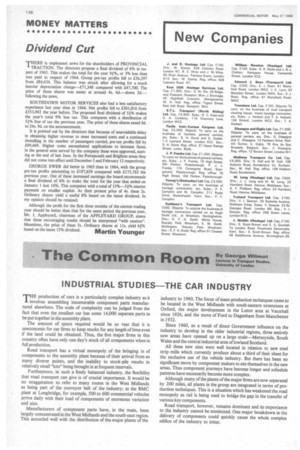The Common Room
Page 138

If you've noticed an error in this article please click here to report it so we can fix it.
INDUSTRIAL STUDIES THE CAR INDUSTRY
THE production of cars is a particularly complex industry as it involves assembling innumerable component parts manufactured elsewhere. The scale of complexity can be judged from the fact that even the smallest car has some 14,000 separate parts to be put together in the assembly plant.
The amount of space required would be so vast that it is uneconomic for car firms to keep stocks for any length of time even if the land could be obtained. Thus, the five major firms in this country often have only one day's stock of all components when in full production.
Road transport has a virtual monopoly of the bringing in of components to the assembly plant because of their arrival from so many diverse points, and the inability to stock-pile results in relatively small "lots" being brought in at frequent intervals.
Furthermore, in such a finely balanced industry, the flexibility that road transport can give is of crucial importance. It would be no exaggeration to refer to many routes in the West Midlands as being part of the conveyor belt of the industry; at the BMC plant at Longbridge, for example, 500 to 600 commercial vehicles arrive daily with their load of components of enormous variation and size.
Manufacturers of component parts have, in the main, been largely concentrated in the West Midlands and the south-east region. This accorded well with the distribution of the major plants of the industry to 1960. The focus of mass-production techniques came to be located in the West Midlands with south-eastern extensions at Oxford, the major development in the Luton area at Vauxhall since 1926, and the move of Ford to Dagenham from Manchester in 1932.
Since 1960, as a result of direct Government influence on the industry to develop in the older industrial regions, three entirely new areas have opened up on a large scale-Merseyside, South Wales and the central industrial area of lowland Scotland.
All these new sites were well located in relation to new steel strip mills which currently produce about a third of their sheet for the exclusive use of the vehicle industry. But there has been no significant move by component makers to site themselves in the new areas. Thus component journeys have become longer and schedule patterns have necessarily become more complex.
Although many, of the plants of the major firms are now separated by 200 miles, all plants in the group are integrated in terms of production techniques. This is a situation which has weakened the road monopoly as rail is being used to bridge the gap in the transfer of various key components.
Road transport, however, remains dominant and its importance to the industry cannot be minimized. One major breakdown in the delivery of components could quickly cause the whole complex edifice of the industry to totter.




































































































































































































































































